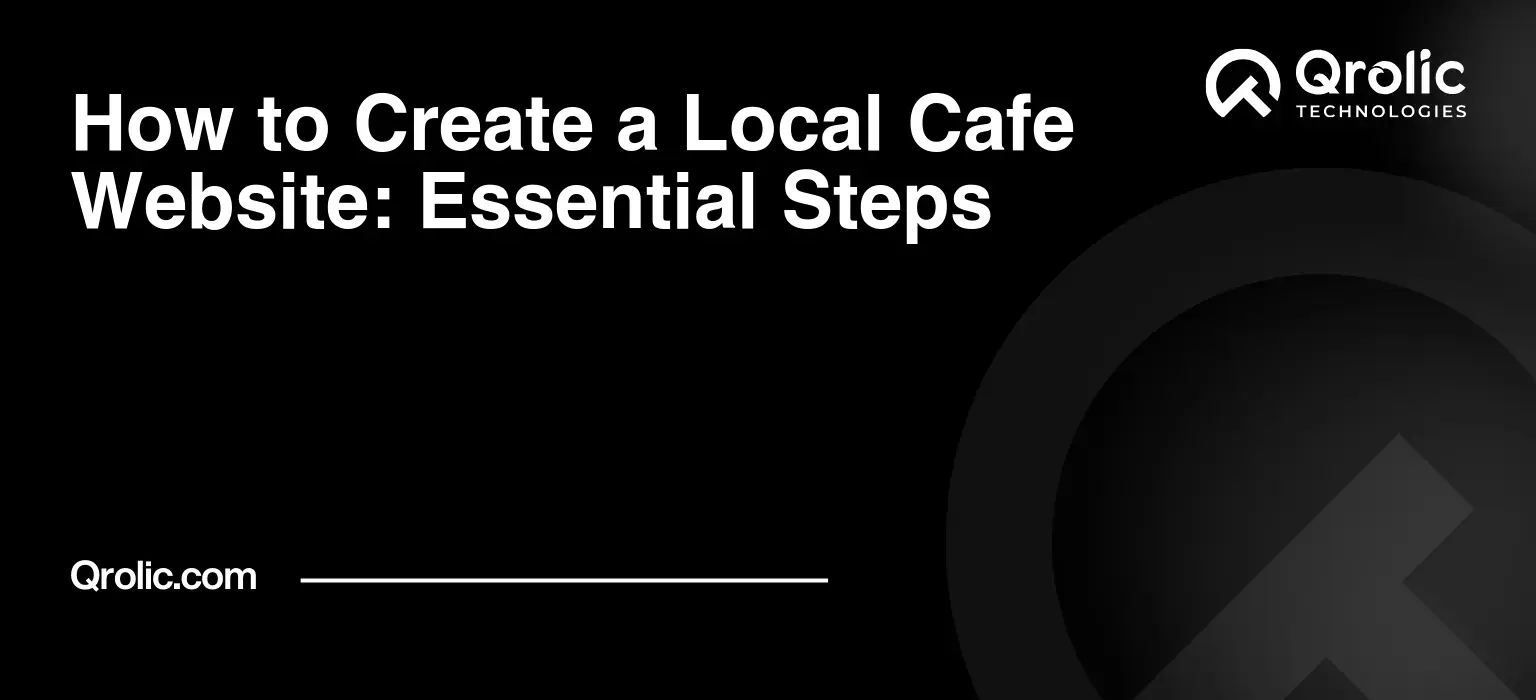Quick Summary:
- A website is vital for cafe growth.
- Plan, build, and optimize your site.
- Use great photos and clear menu design.
- Always monitor and secure your website.
Table of Contents
- 1. Why Your Local Cafe Needs a Website: More Than Just a Menu
- 1.1. Expanding Your Reach and Attracting New Customers
- 1.2. Boosting Customer Engagement and Loyalty
- 1.3. Improving Your Brand Image and Credibility
- 1.4. Driving Sales and Increasing Revenue
- 2. Essential Steps to Creating Your Local Cafe Website: A Comprehensive Guide
- 2.1. Defining Your Website Goals and Target Audience
- 2.2. Choosing a Domain Name and Web Hosting Provider
- 2.3. Selecting a Website Platform: WordPress (Recommended)
- 2.4. Choosing a Website Theme: Design and Functionality
- 2.5. Installing Essential Plugins: Expanding Functionality
- 2.6. Creating Essential Pages: Providing Information
- 2.7. Optimizing Content for SEO: Getting Found Online
- 2.8. Setting Up Online Ordering and Reservations (If Applicable)
- 2.9. Testing and Launching Your Website: Going Live
- 2.10. Promoting Your Website: Getting the Word Out
- 3. Food Service Design: Creating a Visual Feast Online
- 3.1. High-Quality Food Photography: Tempting Taste Buds
- 3.2. Menu Design: Clear, Concise, and Appetizing
- 3.3. Website Layout and Navigation: User-Friendly Experience
- 3.4. Branding and Visual Identity: Reflecting Your Cafe’s Personality
- 4. Qrolic Technologies: Your Partner in Food Service Design and Website Development
- 4.1. Our Services
- 4.2. Why Choose Qrolic Technologies?
- 4.3. Let Us Help You Create Your Dream Cafe Website
- 5. Monitoring and Maintaining Your Website: Long-Term Success
- 5.1. Website Analytics: Tracking Performance
- 5.2. Website Security: Protecting Your Data
- 5.3. Content Updates: Keeping Things Fresh
- 5.4. Website Speed Optimization: Ensuring a Fast Experience
1. Why Your Local Cafe Needs a Website: More Than Just a Menu
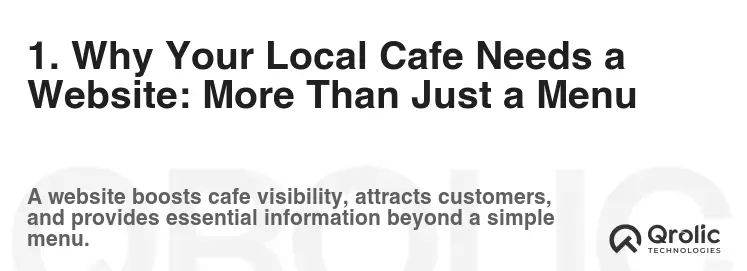
Having a website isn’t just a “nice-to-have” for your local cafe; it’s a “must-have” in today’s digital landscape. Think of your website as your 24/7 digital storefront, welcoming customers even when your physical doors are closed. But why exactly is it so crucial? Let’s delve into the compelling reasons:
1.1. Expanding Your Reach and Attracting New Customers
- Local SEO Powerhouse: A well-optimized website helps you rank higher in local search results (think “best coffee near me”). When potential customers are searching for a cafe, your website can be the first thing they see, drawing them in.
- Beyond Word-of-Mouth: Word-of-mouth is great, but it’s limited. Your website expands your reach exponentially, allowing people from anywhere to discover your cafe.
- Showcasing Your Unique Vibe: Your website allows you to control your narrative and present your cafe’s unique atmosphere, menu items, and overall personality to potential customers.
- Targeted Advertising: A website allows you to run targeted online advertising campaigns specifically aimed at people in your local area, driving traffic to your cafe.
1.2. Boosting Customer Engagement and Loyalty
- Easy Access to Information: Customers want to know your hours, menu, location, and contact details instantly. Your website provides this information at their fingertips.
- Online Ordering and Reservations: Streamline the ordering process with online ordering for pickup or delivery. Implement a reservation system to manage seating and reduce wait times, enhancing customer experience.
- Special Offers and Promotions: Announce limited-time offers, discounts, and events through your website, encouraging repeat visits.
- Customer Feedback and Interaction: Integrate a blog or comment section to gather customer feedback, respond to inquiries, and build a community around your cafe.
- Build an Email List: Offer incentives to collect email addresses for marketing, sending newsletters and special offers to encourage repeat visits.
1.3. Improving Your Brand Image and Credibility
- Professional Representation: A well-designed website instantly adds credibility and portrays your cafe as a professional and reliable establishment.
- Visual Appeal and Storytelling: Use high-quality photos and videos to showcase your food, ambiance, and team. Tell your cafe’s story and connect with customers on an emotional level.
- Building Trust: Display customer testimonials and reviews on your website to build trust and social proof, reassuring potential customers that your cafe is worth a visit.
- Competitive Edge: In a competitive market, a website sets you apart from cafes without an online presence, giving you a significant advantage.
1.4. Driving Sales and Increasing Revenue
- Direct Online Sales: Offer online ordering and delivery options, directly boosting your sales and reaching customers who might not be able to visit in person.
- Increased Foot Traffic: A well-optimized website drives traffic to your physical location, leading to increased sales and revenue.
- Upselling and Cross-Selling Opportunities: Promote complementary items and special offers on your website to encourage customers to spend more.
- Data-Driven Insights: Track website analytics to understand customer behavior, identify popular menu items, and optimize your marketing efforts to drive sales.
In short, a website is an investment that pays off by attracting new customers, boosting loyalty, enhancing your brand image, and ultimately driving sales and increasing revenue. It’s the cornerstone of your modern marketing strategy for your local cafe.
2. Essential Steps to Creating Your Local Cafe Website: A Comprehensive Guide
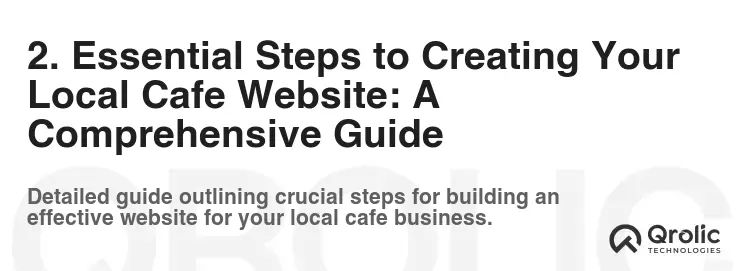
Now that you understand the “why,” let’s dive into the “how.” Creating a website doesn’t have to be intimidating. This comprehensive guide breaks down the essential steps into manageable tasks.
2.1. Defining Your Website Goals and Target Audience
Before you start building, take a step back and define your goals. What do you want your website to achieve? Who are you trying to reach?
-
What are your primary website goals?
- Increase online orders?
- Drive more foot traffic to your cafe?
- Build brand awareness and loyalty?
- Promote events and special offers?
- Collect customer feedback?
-
Who is your target audience?
- Local residents?
- Students?
- Business professionals?
- Tourists?
- Families?
Understanding your goals and target audience will help you make informed decisions about your website’s design, content, and functionality. For example, if your target audience is students, you might want to offer student discounts and promote your website on social media platforms popular with students. If your goal is to increase online orders, you’ll need to prioritize a user-friendly online ordering system.
2.2. Choosing a Domain Name and Web Hosting Provider
Your domain name is your website’s address on the internet (e.g., yourcafe.com). Your web hosting provider is where your website’s files are stored and served to visitors.
-
Choosing a Domain Name:
- Keep it short and memorable: Easy to spell and remember.
- Reflect your brand: Use your cafe’s name or a relevant keyword.
- Use a common extension: .com is generally preferred.
- Check availability: Use a domain name registrar (like GoDaddy or Namecheap) to see if your desired domain name is available.
- Consider local SEO: If your cafe’s name isn’t location-specific, consider including your city in the domain name (e.g., cafesanfrancisco.com).
-
Choosing a Web Hosting Provider:
- Reliability and uptime: Choose a provider with a high uptime guarantee (99.9% or higher).
- Scalability: Ensure the provider can handle increased traffic as your website grows.
- Customer support: Look for providers with responsive and helpful customer support.
- Security: Ensure the provider offers security features like SSL certificates and malware protection.
- WordPress compatibility: If you plan to use WordPress (recommended), choose a provider that offers optimized WordPress hosting.
- Popular options: Bluehost, SiteGround, HostGator, and WP Engine are all reputable web hosting providers.
Consider your budget, technical expertise, and website needs when choosing a hosting plan. Shared hosting is a good starting point for small businesses, while VPS or dedicated hosting offers more power and control for larger websites.
2.3. Selecting a Website Platform: WordPress (Recommended)
There are several website platforms to choose from, but WordPress is the most popular and versatile option for small businesses.
-
Why WordPress?
- User-friendly: Easy to learn and use, even for non-technical users.
- Highly customizable: Thousands of themes and plugins to customize your website’s design and functionality.
- SEO-friendly: Built-in SEO features and plugins to help you rank higher in search results.
- Scalable: Can handle increased traffic and complexity as your business grows.
- Large community and support: Extensive online resources and a large community of users and developers.
- Cost-effective: WordPress itself is free, and many themes and plugins are also free or affordable.
-
Alternative Platforms:
- Squarespace: Easy-to-use website builder with a drag-and-drop interface.
- Wix: Similar to Squarespace, with a wide range of templates and features.
- Shopify: Best for e-commerce businesses with a focus on online sales.
While Squarespace and Wix are easier to set up initially, WordPress offers more flexibility and control in the long run, especially for SEO and customization.
2.4. Choosing a Website Theme: Design and Functionality
Your website theme determines the overall design and layout of your website. Choose a theme that is visually appealing, user-friendly, and relevant to your cafe’s brand.
-
Key Considerations:
- Responsiveness: Ensure the theme is responsive and looks good on all devices (desktops, tablets, and smartphones).
- Mobile-friendliness: Prioritize mobile users as many people will be searching for your cafe on their phones.
- Clean and modern design: Avoid cluttered or outdated designs.
- Easy navigation: Make it easy for visitors to find the information they need.
- Fast loading speed: Optimize the theme for speed to improve user experience and SEO.
- Customization options: Choose a theme that allows you to customize the colors, fonts, and layout to match your brand.
- Compatibility with essential plugins: Ensure the theme is compatible with plugins like WooCommerce (for online ordering) and Yoast SEO (for SEO).
-
Where to Find Themes:
- WordPress Theme Directory: Thousands of free themes.
- ThemeForest: A marketplace for premium themes.
- Elegant Themes: A subscription-based service with access to multiple themes.
Look for themes specifically designed for restaurants or cafes, as they often include features like menu displays, online ordering integrations, and reservation systems.
2.5. Installing Essential Plugins: Expanding Functionality
Plugins are like apps for your website, adding functionality and features that aren’t included in the core WordPress installation.
-
Essential Plugins for Your Cafe Website:
- Yoast SEO: Optimizes your website for search engines.
- Contact Form 7: Creates contact forms for inquiries and reservations.
- WooCommerce: Enables online ordering and e-commerce functionality.
- Google Analytics: Tracks website traffic and user behavior.
- W3 Total Cache or WP Super Cache: Improves website speed and performance.
- Akismet Anti-Spam: Protects your website from spam comments.
- Social Media Sharing Plugins: Allows visitors to easily share your content on social media.
- Review Plugins: Allow customers to leave reviews directly on your website.
- Image Optimization Plugins: Optimize image sizes to improve website speed.
Install only the plugins you need, as too many plugins can slow down your website. Keep your plugins updated to ensure security and compatibility.
2.6. Creating Essential Pages: Providing Information
Your website should include several essential pages to provide visitors with the information they need.
- Homepage: Your website’s front door. Use compelling visuals and clear messaging to capture visitors’ attention and guide them to important information.
- About Us: Tell your cafe’s story, highlight your mission and values, and introduce your team.
- Menu: Display your menu items with high-quality photos and descriptions. Consider offering a downloadable PDF version of your menu.
- Location and Hours: Provide your cafe’s address, phone number, and hours of operation. Embed a Google Map to make it easy for visitors to find you.
- Contact Us: Include a contact form and your email address.
- Online Ordering (if applicable): A dedicated page for online ordering, integrated with WooCommerce or a similar plugin.
- Reservations (if applicable): A page for making reservations, integrated with a reservation plugin.
- Blog (optional): Share news, events, recipes, and other content to engage your audience and improve your SEO.
- Gallery: Showcase photos of your food, ambiance, and events.
Each page should have a clear purpose and be optimized for relevant keywords. Use high-quality images and videos to enhance the visual appeal of your website.
2.7. Optimizing Content for SEO: Getting Found Online
SEO (Search Engine Optimization) is the process of optimizing your website to rank higher in search engine results.
-
Keyword Research: Identify the keywords that your target audience is using to search for cafes like yours (e.g., “coffee shop near me,” “best brunch in [city]”).
-
On-Page Optimization:
- Use keywords in your page titles and descriptions.
- Use keywords in your headings and body text.
- Optimize your images with alt text that includes relevant keywords.
- Create high-quality, informative content that is relevant to your target audience.
- Ensure your website is mobile-friendly.
- Improve your website’s loading speed.
- Use internal links to connect different pages on your website.
-
Off-Page Optimization:
- Build backlinks from other websites (e.g., local directories, food blogs).
- Promote your website on social media.
- Encourage customers to leave reviews on Google My Business and Yelp.
-
Local SEO:
- Claim and optimize your Google My Business listing.
- List your cafe in local directories (e.g., Yelp, TripAdvisor).
- Encourage customers to leave reviews.
- Use local keywords in your website content.
SEO is an ongoing process. Regularly update your website with fresh content, monitor your search engine rankings, and adapt your strategy as needed.
2.8. Setting Up Online Ordering and Reservations (If Applicable)
If you plan to offer online ordering or reservations, you’ll need to integrate your website with a suitable platform.
-
Online Ordering:
- WooCommerce: A popular e-commerce plugin for WordPress that allows you to create an online store and manage orders.
- Third-Party Platforms: Services like Grubhub, DoorDash, and Uber Eats can integrate with your website and handle online ordering and delivery.
- Key Features:
- User-friendly ordering process.
- Secure payment gateway.
- Order tracking and management.
- Delivery options (pickup, delivery, curbside).
- Customizable menu items and options.
-
Reservations:
- OpenTable: A popular online reservation platform.
- Resy: Another popular reservation platform with advanced features.
- WordPress Reservation Plugins: Plugins like Bookly or Amelia allow you to manage reservations directly on your website.
- Key Features:
- Real-time availability.
- Table management.
- Automated confirmations and reminders.
- Customer database.
- Integration with your POS system.
Choose the platform that best suits your needs and budget. Ensure that the integration is seamless and user-friendly.
2.9. Testing and Launching Your Website: Going Live
Before launching your website, thoroughly test it to ensure that everything is working correctly.
-
Testing Checklist:
- Test all links to ensure they are working.
- Test all forms to ensure they are submitting correctly.
- Test your website on different browsers and devices.
- Test your website’s loading speed.
- Test your online ordering and reservation systems (if applicable).
- Proofread all content for errors.
- Check your website’s responsiveness on different screen sizes.
Once you’ve thoroughly tested your website, you’re ready to launch it.
-
Launching Your Website:
- Point your domain name to your web hosting server.
- Submit your website to search engines (Google, Bing).
- Promote your website on social media and other channels.
- Monitor your website traffic and analytics.
2.10. Promoting Your Website: Getting the Word Out
Launching your website is just the first step. You need to actively promote it to attract visitors.
-
Promotional Strategies:
- Social Media Marketing: Share your website on social media platforms and engage with your followers.
- Email Marketing: Build an email list and send newsletters with special offers and updates.
- Local SEO: Optimize your website and Google My Business listing for local search.
- Online Advertising: Run targeted online advertising campaigns on Google Ads and social media.
- Content Marketing: Create blog posts, videos, and other content that is relevant to your target audience.
- Partnerships: Partner with other local businesses to cross-promote each other’s websites.
- Print Marketing: Include your website address on your menus, business cards, and other print materials.
- Public Relations: Reach out to local media outlets to get coverage for your cafe.
- Loyalty Programs: Reward customers for visiting your website and making purchases.
Continuously monitor your marketing efforts and adjust your strategy as needed.
3. Food Service Design: Creating a Visual Feast Online
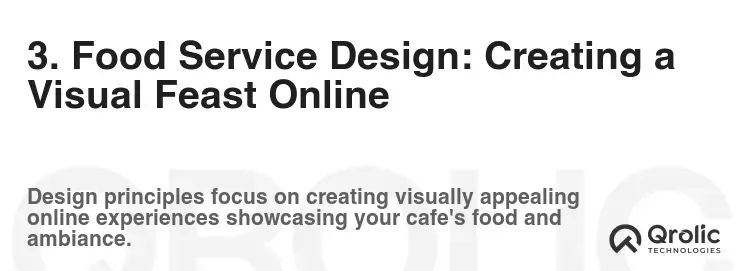
Your website is a digital representation of your cafe. Just as you carefully design your physical space, you should pay close attention to the food service design of your website. This involves creating a visually appealing and user-friendly experience that showcases your menu and ambiance.
3.1. High-Quality Food Photography: Tempting Taste Buds
Food photography is crucial for enticing visitors to try your menu items.
- Invest in Professional Photography: Hire a professional food photographer to capture high-quality images of your dishes.
- Showcase the Details: Capture the textures, colors, and presentation of your food in detail.
- Use Natural Lighting: Natural lighting is ideal for food photography.
- Optimize Images for the Web: Compress your images to reduce file size and improve loading speed.
- Use Consistent Styling: Maintain a consistent style and aesthetic in your food photography.
- Include Variety: Showcase a variety of menu items, including appetizers, entrees, desserts, and drinks.
- Consider Action Shots: Capture images of people enjoying your food to create a sense of community and atmosphere.
Avoid using stock photos, as they can look generic and unappealing. High-quality food photography is an investment that will pay off by driving sales and attracting new customers.
3.2. Menu Design: Clear, Concise, and Appetizing
Your menu is one of the most important elements of your website. Make sure it is easy to read, navigate, and understand.
- Use a Clear and Legible Font: Choose a font that is easy to read on all devices.
- Organize Your Menu Logically: Group menu items by category (e.g., appetizers, entrees, desserts).
- Include Detailed Descriptions: Provide descriptions of each menu item that highlight the ingredients and flavors.
- List Prices Clearly: Make sure prices are clearly visible for each item.
- Use High-Quality Images: Include photos of your menu items to entice visitors.
- Offer a Downloadable PDF: Provide a downloadable PDF version of your menu for easy access.
- Highlight Special Items: Use visual cues to highlight special items, such as daily specials or popular dishes.
- Consider Dietary Restrictions: Indicate which items are vegetarian, vegan, or gluten-free.
Avoid using cluttered or overly designed menus. A clean and simple menu is more effective at conveying information and enticing customers.
3.3. Website Layout and Navigation: User-Friendly Experience
Your website’s layout and navigation should be intuitive and easy to use.
- Use a Clear and Consistent Navigation Menu: Make it easy for visitors to find the information they need.
- Use a Simple and Clean Design: Avoid cluttered or distracting designs.
- Use White Space Effectively: White space helps to create a sense of balance and visual appeal.
- Use Calls to Action: Use clear calls to action to guide visitors to important actions, such as making a reservation or placing an order.
- Ensure Mobile-Friendliness: Make sure your website is responsive and looks good on all devices.
- Test Your Website’s Usability: Ask friends or family to test your website and provide feedback.
A well-designed website layout and navigation will improve user experience and encourage visitors to spend more time on your site.
3.4. Branding and Visual Identity: Reflecting Your Cafe’s Personality
Your website should reflect your cafe’s brand and visual identity.
- Use Your Cafe’s Logo and Colors: Maintain consistency between your website and your other branding materials.
- Choose a Font That Reflects Your Brand: Choose a font that is consistent with your brand’s personality.
- Use High-Quality Images That Reflect Your Brand: Choose images that are consistent with your brand’s style and aesthetic.
- Tell Your Cafe’s Story: Share your cafe’s story and mission on your website.
- Create a Consistent Brand Voice: Use a consistent tone of voice throughout your website.
- Showcase Your Cafe’s Atmosphere: Use images and videos to showcase your cafe’s ambiance.
A strong brand identity will help you to stand out from the competition and create a memorable experience for your customers.
4. Qrolic Technologies: Your Partner in Food Service Design and Website Development

Qrolic Technologies (https://qrolic.com/) is a leading provider of food service design and website development services. We specialize in helping restaurants and cafes create stunning online experiences that attract customers and drive sales.
4.1. Our Services
- Website Design and Development: We create custom websites that are tailored to your specific needs and goals.
- Food Photography: We offer professional food photography services to showcase your menu items in the best possible light.
- Menu Design: We design menus that are both visually appealing and easy to read.
- SEO Optimization: We optimize your website for search engines to help you rank higher in search results.
- Online Ordering and Reservation Systems: We integrate your website with online ordering and reservation platforms.
- Social Media Marketing: We help you promote your website and cafe on social media.
- Content Marketing: We create blog posts, videos, and other content that is relevant to your target audience.
4.2. Why Choose Qrolic Technologies?
- Experience: We have years of experience in the food service industry.
- Expertise: We have a team of skilled designers, developers, and marketers.
- Custom Solutions: We create custom solutions that are tailored to your specific needs.
- Results-Driven: We are committed to helping you achieve your business goals.
- Affordable Prices: We offer competitive prices and flexible payment options.
- Exceptional Customer Service: We provide exceptional customer service and support.
4.3. Let Us Help You Create Your Dream Cafe Website
Contact Qrolic Technologies today to learn more about our services and how we can help you create a stunning website for your local cafe. Visit our website at https://qrolic.com/ to request a free consultation.
5. Monitoring and Maintaining Your Website: Long-Term Success
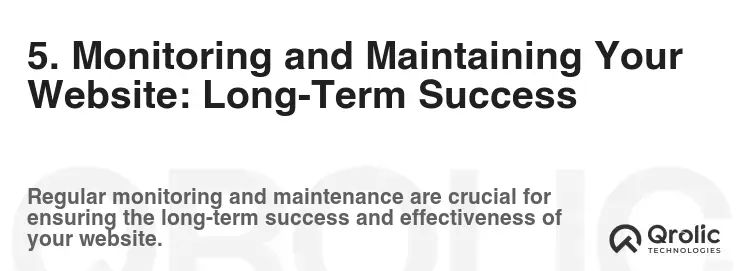
Creating your website is a significant accomplishment, but it’s not a “set it and forget it” project. Ongoing monitoring and maintenance are essential for long-term success.
5.1. Website Analytics: Tracking Performance
- Google Analytics: Track website traffic, user behavior, and conversions.
- Key Metrics:
- Traffic Sources: Where are your visitors coming from (e.g., search engines, social media, referrals)?
- Page Views: Which pages are the most popular?
- Bounce Rate: How many visitors leave your website after viewing only one page?
- Conversion Rate: How many visitors complete a desired action (e.g., placing an order, making a reservation)?
- Mobile vs. Desktop Traffic: How many visitors are using mobile devices vs. desktops?
Regularly analyze your website analytics to identify areas for improvement and optimize your marketing efforts.
5.2. Website Security: Protecting Your Data
- Regular Backups: Back up your website regularly to prevent data loss in case of a security breach or technical issue.
- Software Updates: Keep your WordPress installation, themes, and plugins updated to the latest versions to patch security vulnerabilities.
- Strong Passwords: Use strong, unique passwords for your WordPress admin account and database.
- Security Plugins: Install security plugins like Wordfence or Sucuri Security to protect your website from malware and hacking attempts.
- SSL Certificate: Ensure your website has an SSL certificate to encrypt data transmitted between your website and visitors.
Security is paramount. Neglecting website security can lead to data breaches, website downtime, and damage to your reputation.
5.3. Content Updates: Keeping Things Fresh
- Regular Blog Posts: Publish new blog posts regularly to engage your audience and improve your SEO.
- Menu Updates: Keep your menu up-to-date with seasonal items and price changes.
- Event Announcements: Promote upcoming events and special offers on your website.
- Testimonials and Reviews: Add new testimonials and reviews to build trust and social proof.
- Image Updates: Refresh your website with new images of your food, ambiance, and team.
Keeping your website content fresh and engaging will encourage visitors to return and improve your SEO.
5.4. Website Speed Optimization: Ensuring a Fast Experience
- Image Optimization: Compress your images to reduce file size and improve loading speed.
- Caching Plugins: Use caching plugins like W3 Total Cache or WP Super Cache to improve website speed.
- Content Delivery Network (CDN): Use a CDN to distribute your website’s content across multiple servers, improving loading speed for visitors around the world.
- Minimize HTTP Requests: Reduce the number of HTTP requests by combining CSS and JavaScript files.
- Choose a Fast Web Hosting Provider: Choose a web hosting provider with optimized servers for speed and performance.
Website speed is a critical factor for user experience and SEO. A slow website can frustrate visitors and negatively impact your search engine rankings.
By following these essential steps, you can create a stunning and effective website for your local cafe that attracts customers, boosts loyalty, and drives sales. Remember to continuously monitor, maintain, and promote your website to ensure long-term success. Good luck!
